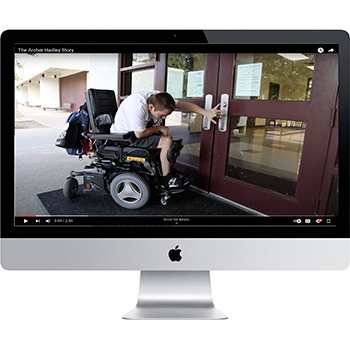| RECENT | A Lot to LearnGAO report says 2/3 of school districts have physical barriers that may limit accessBlog 19, June 2023 School is out for summer, but the work never stops for district administrators and facility managers. It’s a good thing, too, because the Government Accountability Office (GAO) reports that school districts in the U.S. have a lot of work to do when it comes to making schools accessible for students and staff with disabilities. The GAO report (from 2020) revealed that two-thirds of school districts had facilities with physical barriers that may limit access. Barriers, such as a lack of accessible door hardware and steep ramps, can make it challenging for students, teachers, and others with disabilities to use public school facilities. Also, nearly one in five districts had schools that typically do not serve students with physical disabilities because of the barriers in their buildings. Barriers existed regardless of the age or condition of the facility, but were most prevalent in buildings that were over 25 years old. An estimated 70 percent of districts had large-scale renovations, small-scale upgrades, or accessibility evaluations planned in the subsequent three calendar years, but frequently cited funding constraints as a challenge to these efforts. Districts also identified the need to prioritize projects that keep buildings operational, such as roofing and heating projects. The GAO recommended that the Justice Dept. work with the Dept. of Education to provide information specific to accessibility of public school facilities and provide information on federal accessibility requirements in the context of public school safety and security. This summer is a good time for districts to begin facility planning and construction upgrades for next year. Since 1977, it’s been law that new school construction as well as renovation to existing facilities must include accommodations for students with disabilities. Also, since 2021, the International Building Code (IBC) now requires many buildings to be equipped with automatic operators on at least one door or pair of doors at each public, accessible entrance. It’s an update to the IBC that AAADM had been working on for a decade. Still, a patchwork of federal laws governs accessible school construction, including Section 504 of the Rehabilitation Act of 1973, the Americans with Disabilities Act (ADA) of 1990, and the Individuals with Disabilities Education Act (IDEA), which requires public schools to make available to all eligible children with disabilities a free, appropriate public education in the least restrictive environment appropriate to their individual needs. For students with mobility issues, a commonly desired accommodation is automatic doors at entrances and even key interior doorways. At least 60% of public pedestrian entrances for facilities are required to comply with ADA standards. Note that the 60% figure is always rounded up. Here’s an example: If there are two public entry/exit doors for a facility, 60% of 2 is 1.2, so BOTH doors would have to comply. Automatic doors are so important to students with disabilities that one Texas high school student with cerebral palsy raised $87,000 to install them at Austin High School (see the story of that student, Archer Hadley, here). Facility managers have it within their power to support and improve the lives of students with disabilities. Whole communities can work together to champion inclusion and accessibility for all. And, as the GAO report makes clear, there is still much work to be done. SHARE ON: |
| Automatic Doors Add More 'Service' to Foodservice | |
| Five Years of 'Magic': National Automatic Door Day | |
| 2024: Year in Review | |
| International Persons with Disabilities Day: Enhancing Accessibility for All | |
| Vote for Accessibility: Removing Physical Barriers at Polling Places | |
| Opening "Automatic" Doors for Employees with Disabilities | |
| The Modern Office Building in a No-Touch World | |
| Summer's Here and the Time is Right for ... Addressing School Access | |
| July is Disability Pride Month: Why Aren't Automatic Doors Mandated by the ADA? | |
| The Important Work of the U.S. Access Board | |
| Rolling Out the Red Carpet for National Automatic Door Day | |
| New Certification Program for 2024 | |
| International Persons with Disabilities Day | |
| The Right to Vote | |
| The Modernity and Aesthetics of Automatic Doors | |
| July is Disability Pride Month | |
| A Lot to Learn | |
| ASSA ABLOY's Dave Timmerman is New President of American Association of Automatic Door Manufacturers | |
| Automatic Doors: Champions of Access | |
| AAADM Leadership Delivers U.S. Access Board Webinar | |
| AAADM at 30: Safety is the Great Uniter | |
| Philadelphia Freedom | |
| Door Doctors | |
| Safe With Us | |
| State of the ADA | |
| A Clear Path to Voting | |
| "GREEN" Doors: Earth Day and Automatic Doors | |
| Do the right things, get money back | |
| The Second Annual Automatic Door Day | |
| FOOD FOR THOUGHT Restaurant patrons overwhelmingly say they want automatic doors | |
| My Electrician Says He Can Fix My Automatic Door. Should I Let Him? | |
| Automatic Doors Have Graduated Beyond Entryways | |
| Greet Your Guests in the New No-Touch World | |
| Automatic Door Day | |
| IBC Building Code | |

